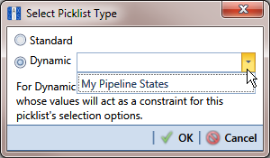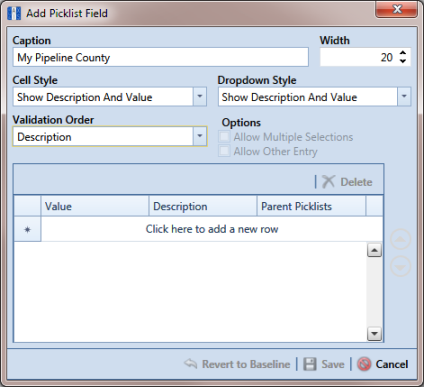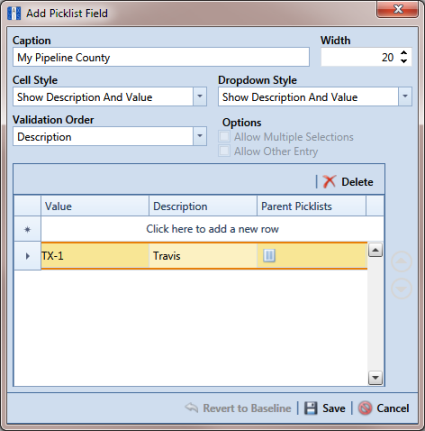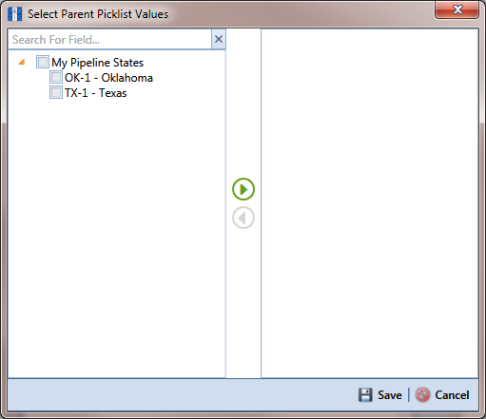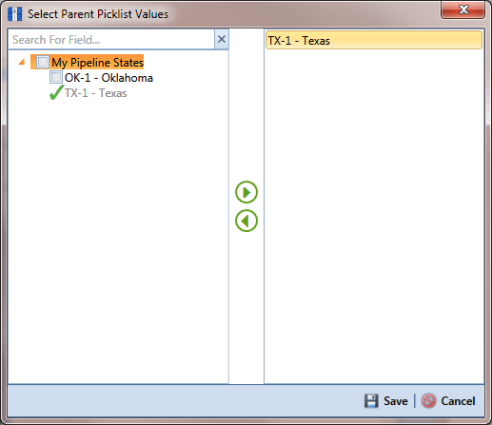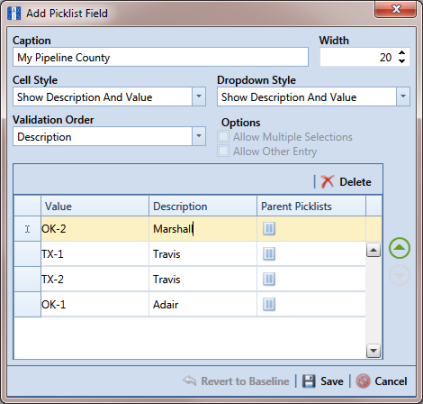Adding a Child Picklist and Mapping Data Items
Complete the following steps to add a child picklist and then map data items in the child picklist to data items in a parent picklist:
1 If the
Field and UDF Customizations window is not open, click
Tools >
Field and UDF Customizations to open the window (
Figure 3-48).
For example, double-click Facility Surveys > CPDM > Test Point > Test Point Inspection to display a grid with fields and property settings related to the Test Point Inspection data entry grid.
3 Click
 Picklist
Picklist in the toolbar of the
Field and UDF Customizations window to open the
Select Picklist Type dialog box (
Figure 3-52).
Figure 3-52. Select Picklist Type
4 Click
Dynamic in the
Select Picklist Type dialog box. Then click the down arrow in the adjacent field and select the parent picklist you want to associate with the child picklist. Click
 OK
OK to close the dialog box.
5 When the dialog box
Add Picklist Field (
Figure 3-53) opens, set properties and add data items for the child picklist in the following manner:
a Type a unique name for the child picklist in the Caption field.
b Indicate the number of characters to allow in the name of the child picklist. Type a value in the Width field or use the up/down arrows to select a value. Clicking the up arrow increases the value; clicking the down arrow decreases the value.
Figure 3-53. Add Picklist Field
6 Choose an option for displaying the child picklist in data entry grids. Click the down arrow in the field Cell Style and select one of the following options in the selection list:
• Show Value: Displays the assigned value of the selected item in the picklist.
• Show Description: Displays the description of the selected item in the picklist.
• Show Value And Description: Displays the assigned value and description of the selected item in the picklist.
• Show Description And Value: Displays the description and assigned value of the selected item in the picklist.
7 Choose an option for displaying data items in the child picklist. Click the down arrow in the field Dropdown Style and select one of the following options:
• Show Value: Displays only the assigned value of items in the child picklist.
• Show Description: Displays only the description of items in the child picklist.
• Show Value And Description: Displays the assigned value and description of items in the child picklist.
• Show Description And Value: Displays the description and assigned value of items in the child picklist.
8 Select an option for sorting data items in the child picklist. Click the down arrow in the field Validation Order and select one of the following options:
• Value: Sorts items numerically based on values assigned to items in the child picklist.
• Description: Sorts items alphanumerically based on the description of items in the child picklist.
• Defined: Sorts items based on the order of items listed in the Customize Picklist dialog box.
Note: The options Allow Multiple Selections and Allow Other Entry are unavailable for selection when adding a child picklist.
9 Complete the following steps to add data items in the child picklist and then map these data items to data items in the associated parent picklist. Data items you add become selections in the drop-down list of the child picklist.
a Click the message Click here to add a new row to add an empty row of fields for data entry.
b Associate a code with the name of the data item. Type one or more letters, numbers, or a combination of both in the Value field. Then type a description for the data item in the Description field.
The example below shows a data item labeled
TX-1 Travis as an item for selection in the child picklist labeled
My Pipeline County (
Figure 3-54).
Figure 3-54. Add Picklist Field
c Click the

parent picklist button to open the dialog box labeled
Select Parent Picklist Values (
Figure 3-55).
Figure 3-55. Select Parent Picklist Values
d Map a data item in the parent picklist to the currently selected data item in the child picklist. A list of data items related to the parent picklist display in the left pane of the dialog box (
Figure 3-56).
• Double-click a data item in the left pane of the dialog box to move the data item to the right pane.
You can also map data items by clicking a data item’s check box and then clicking the

right arrow button. A

check mark beside a data item indicates that data item is mapped.
If you want to unmap a data item, double-click the data item in the right pane of the dialog box to move it back to the left pane. Or, select the data item in the right pane and then click the

left arrow button.
Figure 3-56. Select Parent Picklist Values
e Click
 Save
Save to save settings and close the dialog box.
10 To add another data item in the child picklist, follow these steps (
Figure 3-57):
a Press Enter on the computer keyboard to add another empty row of fields for data entry in the dialog box Add Picklist Field.
b Associate a code with the name of the data item. Type one or more letters, numbers, or a combination of both in the Value field. Then type a description for the data item in the Description field.
The example below shows a data item labeled
OK-2 Marshall as data item for selection in the child picklist labeled
My Pipeline County (
Figure 3-54).
Figure 3-57. Add Picklist Field
c Click the

parent picklist button to open the dialog box labeled
Select Parent Picklist Values (
Figure 3-55).
d Map a data item in the parent picklist to the currently selected data item in the child picklist (
Figure 3-56). Click
 Save
Save when you finish to save settings and close the dialog box.
e To add additional data items in the child picklist, repeat
step 10 "a" through
"d". When you finish adding and mapping all data items in the child picklist, click
 Save
Save to close the dialog box and return to the
Field and UDF Customizations window.
The process for adding a
Dynamic Picklist UDF is now complete. You can add the
Dynamic Picklist (parent and child picklist fields) in the layout theme of a data grid, form, or report, as well as in a prompt theme for prompts sent to the Allegro Field Computer. Refer to
Working with Themes and Filter Groups for information. For information about editing a picklist, refer to
Editing a Picklist (Standard or Dynamic).
 Picklist in the toolbar of the Field and UDF Customizations window to open the Select Picklist Type dialog box (Figure 3-52).
Picklist in the toolbar of the Field and UDF Customizations window to open the Select Picklist Type dialog box (Figure 3-52). 